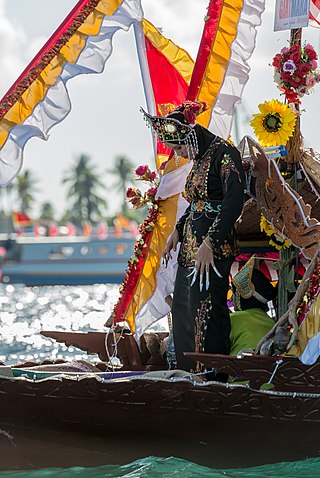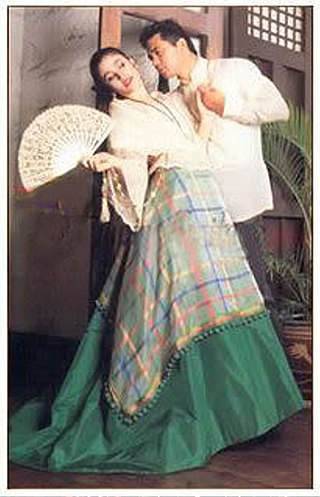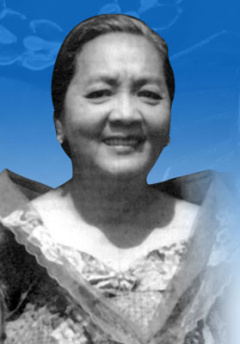
A folk dance is a dance that reflects the life of the people of a certain country or region. Not all ethnic dances are folk dances. For example, ritual dances or dances of ritual origin are not considered to be folk dances. Ritual dances are usually called "religious dances" because of their purpose.

The music of the Philippines includes the musical performance arts in the Philippines and the music of Filipinos composed in various local and international genres and styles. Philippine musical compositions are often a mixture of Indigenous styles, and various Asian styles, as well as Spanish/Latin American and (US) American influences through foreign rule from those countries.
The culture of the Philippines is characterized by cultural and ethnic diversity. Although the multiple ethnic groups of the Philippine archipelago have only recently established a shared Filipino national identity, their cultures were all shaped by the geography and history of the region, and by centuries of interaction with neighboring cultures, and colonial powers. In more recent times, Filipino culture has also been influenced through its participation in the global community.

Tanauan, officially the Municipality of Tanauan, is a First Income Class municipality in the province of Leyte, Philippines. According to the 2020 census, it has a population of 57,455 people.

The traditional music of the Philippines reflects the Philippines' diverse culture, originating from more than 100 ethnolinguistic groups and shaped by a widely varying historical and sociocultural milieu.

Singkil is an ethnic dance of the Philippines that has its origins in the Maranao people of Lake Lanao, a Mindanao Muslim ethnolinguistic group. The dance is widely recognized today as the royal dance of a prince and a princess weaving in and out of crisscrossed bamboo poles clapped in syncopated rhythm. While the man manipulates a sword and shield, the woman gracefully twirls a pair of fans. The dance takes its name from the belled accessory worn on the ankles of the Maranao princess. A kulintang and agung ensemble always accompanies the dance. Singkil has evolved over time, with significant reinterpretations and changes introduced by the Bayanihan folk dance group, such as the incorporation of the elements from the Darangen epic, particularly the episodes involving Prince Bantugan and Princess Gandingan.

Pangalay is the traditional "fingernail" dance of the Tausūg people of the Sulu Archipelago and eastern coast Bajau of Sabah.

The cariñosa is a Philippine dance of colonial-era origin from the Maria Clara suite of Philippine folk dances, where the fan or handkerchief plays an instrumental role as it places the couple in a romance scenario.

The baro’t saya or baro at saya is a traditional dress ensemble worn by women in the Philippines. It is a national dress of the Philippines and combines elements from both the precolonial native Filipino and colonial Spanish clothing styles. It traditionally consists of four parts: a blouse, a long skirt, a kerchief worn over the shoulders, and a short rectangular cloth worn over the skirt.
Michael Amper Dadap is a popular Filipino guitarist, composer, and conductor, and an influential advocate of Filipino folk music. He was influential in the creation of a world-class rondalla ensemble in the United States is also the founding music director of the Iskwelahang Rondalla of Boston, Massachusetts.
The arts in the Philippines reflect a range of artistic influences on the country's culture, including indigenous art. Philippine art consists of two branches: traditional and non-traditional art. Each branch is divided into categories and subcategories.
The Philippines is home to several folk dances such as Tinikling, Pandanggo, Cariñosa, and Subli. Dance has integrated itself in Philippine society over the course of many years and is imbedded in Philippine culture.

The Maglalatik is a folk dance from the Philippines performed by male dancers. Coconut shell halves are secured onto the dancers' hands and on vests upon which are hung four or six more coconut shell halves. The dancers are shirtless and wear only red pants. The dancers dance by hitting one coconut shell with the other; sometimes the ones on the hands, the ones on the body, or the shells worn by another performer, all in time to a fast drumbeat.

Traditional marriage customs in the Philippines and Filipino wedding practices pertain to the characteristics of marriage and wedding traditions established and adhered by them Filipino men and women in the Philippines after a period of adoption courtship and engagement. These traditions extend to other countries around the world where Filipino communities exist. Kasalan is the Filipino word for "wedding", while its root word – kasal – means "marriage". The present-day character of marriages and weddings in the Philippines were primarily influenced by the permutation of Christian, both Catholic and Protestant, Hindu, Islam, Chinese, Spanish, and American models.

The María Clara gown, historically known as the traje de mestiza during the Spanish colonial era, is a type of traditional dress worn by women in the Philippines. It is an aristocratic version of the baro't saya. It takes its name from María Clara, the mestiza protagonist of the novel Noli Me Tángere, penned in 1887 by Filipino nationalist José Rizal. It is traditionally made out of piña, the same material used for the barong tagalog.

The rondalla is an ensemble of stringed instruments played with the plectrum or pick and generally known as plectrum instruments. It originated in Medieval Spain, especially in the ancient Crown of Aragon: Catalonia, Aragon, Murcia, and Valencia. The tradition was later taken to Spanish America and the Philippines. The word rondalla is from the Spanish ronda, meaning "serenade."

Francisca Reyes-Aquino was a Filipino folk dancer and academic noted for her research on Philippine folk dance. She is a recipient of the Republic Award of Merit and the Ramon Magsaysay Award and is a designated National Artist of the Philippines for Dance.
Filipino Americans have a long history of music in the United States. The Philippines have musical context and varied influences due to indigenous traditions and early colonial influences of Spanish and American occupation. During occupation by the United States, many Filipinos were recruited for manual labor along the West Coast. These early laborers commonly would perform Spanish-influenced rondallas as well as choral groups. With many Filipinos living in the United States beginning around the 1900s, Filipinos have contributed towards early Americana staples such as blues and jazz, and continue to influence more modern contemporary genres such as hip hop and rock. American music has also been influential in the Philippines for artists and vice versa. Though contributing to the evolution of American music, large number of Filipino Americans have a strong identity with culture of the Philippines by participating or organizing traditional dances and musical performances, largely in the form of PCNs on university campuses. Traditional dances and musical performances commonly practiced in the US are rondallas, choral groups, and gong chime ensembles. College campuses often organize performances on campuses, but can also have characteristics unique to America, as many Filipino Americans want to share their experiences of living in America and perform a more neo-traditional variation of traditional performances.

Sisingaan, also known as Gotong Singa, Singa Ungkleuk, Singa Depok, Kuda Ungkleuk, Pergosi, or Odong-odong, is a traditional Sundanese lion dance that originated in Subang, West Java, Indonesia. This lion dance performance is marked by a form of an ark or palanquin that resembles a lion. The lion ark or lion-shaped effigy is carried by a group of dancers who perform various attractions accompanied by traditional music. This dance is usually performed to celebrate a child's circumcision ceremony, where the child is carried on the lion around the kampung (village).


















